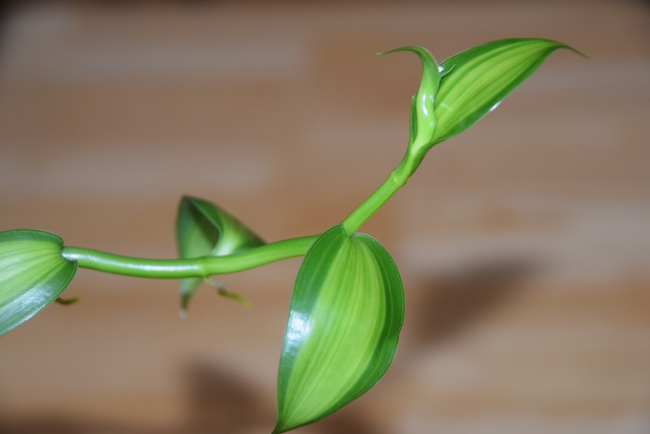- Author: Erin Mahaney
Have you ever just had to have a plant, knowing that that the relationship won't work out in the long run? I'm not talking about the impulse buy that we gardeners all engage in at times, but the well-considered, educated purchase we know won't end well . . . but we just have to give it a try.
Several years ago, I purchased a vanilla plant. I had noticed it in an on-line catalog some time earlier, and although I was intrigued, common sense prevailed. Let's see – a tropical vine that requires warmth (temperatures above 60 degrees) and preferably humidity above 50 percent—ideally a greenhouse environment in our climate—takes years to mature before flowering, and has to be hand-pollinated if and when it ever blooms? Not a recipe for success in my cool, wind-blown, Benicia home. (And I confess, I was trying to behave after a failed attempt with a dwarf Jamaican heliconia.)
But then the vanilla plant went on sale and I was lost. For the price of a few lattes, I could hold the hope of harvesting vanilla beans in my own home! Well, I never actually expected to harvest anything, but sometimes the fun is in the trying.
My vanilla plant is a variegated Vanilla planifolia, one of over 60 vanilla orchid species, which is native to Mexico. It is the only orchid that produces an edible fruit. In its home tropical environment, the vanilla vine can grow up to 30 feet (or longer, according to some sources). In the wild, the plant takes up to seven or eight years to mature before blooming, blooms intermittently—and just for one day—with pale yellow or green flowers. The only natural pollinator is a species of Meliponia bee that occurs only in Mexico, and so early efforts to cultivate vanilla elsewhere failed.
The vanilla plant's growth and fruiting habits explain why vanilla beans are so expensive. It wasn't until 1841 before people learned how to artificially pollinate the flowers and vanilla production spread to other tropical and subtropical regions. In commercial production, the plant still takes several years to mature before blooming. Then, each vanilla flower must be hand-pollinated within twelve hours of blooming to bear fruit. The plants don't bloom all at once, but instead bloom over a period of weeks, which requires weeks of labor-intensive hand-pollination. The seed pods then take nine months to mature before they can be harvested and cured for several more months.
After nearly three years, I can report that my vanilla plant is still alive, albeit growing slowly. It is in a room with a southeast-facing window with bright sun, although it isn't a particularly warm room in the house. The first year, the plant did well in the summer, growing nearly a foot and putting out glossy green variegated leaves. The second summer, I thought I was going to lose the plant. It appeared to suffer from root rot and was dying. I almost threw it out, but noticing the aerial roots, decided to try cutting off the dying base and rooting a few of the aerial roots in the soil. It worked! Today, my vanilla vine is glossy and healthy, reaching an estimated 2.5 feet in length as I wind it over a small support. It has grown to the point where I'm considering repotting it with a larger support to climb on, but I'm reluctant to disturb what appears to be working.
I don't really expect to ever see an orchid flower on my vanilla vine, but it's fun to think that it could happen someday. (And if it does, I can only hope that I'm home that day!) In the meantime, the glossy green vining plant is a pretty, interesting, addition when nestled amongst my plant menagerie.






I've just stumbled across your post while googling about vanilla orchids. I, too, have been drawn by the allure of this unusual plant. I'm just wondering now (a year and a half since you originally posted this article) if you've seen any blossoms. A couple of years ago, I ventured into carnivorous plant territory and bought a Venus flytrap after reading up on its care. I must say that I LOVE my Audrey II. She's fascinating and a pleasure to watch (but dormant in the winter). So now, I'm thinking about trying out a vanilla orchid (for precisely the same reasons you've so eloquently stated). I have a couple of phalaenopses that have grown reasonably successfully and a Meyer's lemon tree that I nearly killed, but after a couple of years and a brutal trimming, has pulled a Lazarus and now looks beautiful (cannot describe how satisfying that is!). As you can tell, I love the romantic aspects of the green-thumb challenge posed by trying to grow these types of plants in Maryland (zone 6b) with just a sunroom. Anyway, I'd love to get an update on your vanilla orchid before I try to figure out how anyone can ship such as plant to me in Maryland's February. Thanks so much for sharing your comments. Now, I have to read your other posts. . . .
-Ellice
My vanilla plant is still alive! Unfortunately, I don't think it will ever thrive sufficiently to bloom because it likely requires warmer temperatures and humidity than I can provide. But it is fun to try!